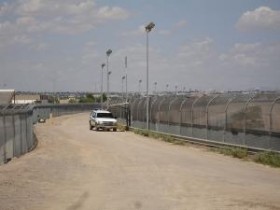The refrain that Mexican drug cartels “now maintain a presence in over 1,000 cities” has been widely heard ever since the claim was first made in a 2011 report by the now defunct National Drug Intelligence Center (NDIC). But the Washington Post reported Sunday that it just isn’t true.

The US-Mexico border. The cartels are mainly on the other side of the fence. (wikimedia.org)
The figure is “misleading at best,” law enforcement sources and drug policy analysts told the Post. The number was arrived by asking law enforcement agencies to self-report and not based on documented criminal cases involving Mexico’s drug trafficking organizations, the so-called cartels.
DEA and Justice Department officials speaking off the record told the Post they didn’t believe the numbers.
“It’s not a DEA number,” said a DEA official who requested anonymity to speak candidly about the report. “We don’t want to be attached to this number at all.”
“I heard that they just cold-called people in different towns, as many as they could, and said, ‘Do you have any Mexicans involved in drugs? And they would say, ‘Yeah, sure,’ ” said a Justice Department official, also speaking on condition of anonymity.
The Post also interviewed police chiefs in towns with supposed cartel presence who said they were surprised to be included in the list of cities penetrated by the cartels.
“That’s news to me,” said Randy Sobel, chief of police in Middleton, NH
“I have no knowledge of that,” said David Lancaster, chief of police in Corinth, MS.
Drug policy and drug trafficking analysts also scoffed at the number.
“They say there are Mexicans operating here and they must be part of a Mexican drug organization,” said Peter Reuter, who co-directed drug research for the non-profit Rand think tank and now works as a professor at the University of Maryland. “These numbers are mythical, and they keep getting reinforced by the echo chamber.”
“Washington loves mythical numbers,” said John Carnevale, a former drug policy and budget official who served three presidents and four “drug czars” at the White House Office of National Drug Control Policy (ONDCP). “Once the number is out there and it comes from a source perceived to be credible, it becomes hard to disprove, almost impossible, even when it’s wrong.”
The analysts said the claim was part of pattern in the drug war of promoting questionable statistics to justify drug enforcement budgets.
“At a time when agency budgets are being cut, you want to demonstrate that you are protecting the public from a menace,” said Eric Sterling, president of the Criminal Justice Policy Foundation, a drug- and policing-policy reform group. “If you say there are Mexican henchmen in 1,000 cities, you don’t want to cut their budget.”
The unjustifiably high number also resulted from definitional problems with the NDIC’s effort.
“These definitions are interchangeable and indistinguishable,” said Peter Andreas, a drug policy analyst at Brown University whose book “Smuggler Nation” was recently reviewed here.”This is a particularly egregious example of a pattern that unfortunately has not gotten a lot of scrutiny.”
The “1,000 cities” canard isn’t the only cartel myth widely circulating. For years, law enforcement in the Western US has claimed that Mexican cartels are behind large-scale marijuana grows in national forests and other public lands.
Then, in January of this year, the ONDCP was forced to admit there was no evidence of cartel involvement in such marijuana grows.
“Based on our intelligence, which includes thousands of cell phone numbers and wiretaps, we haven’t been able to connect anyone to a major cartel,” Tommy Lanier, head of the ONDCP’s National Marijuana Initiative, admitted to the Los Angeles Times in January.
He said law enforcement had long mislabeled marijuana grown on public land as “cartel grows” because Mexican nationals had been arrested in some cases and because raising the cartel threat was good for getting federal funding.
But Lanier’s admission hasn’t stopped local law enforcement from trying to play the cartel card.
Just this month, police in San Luis Obispo, California said a marijuana grow there was “associated with Mexican drug cartels” even though no one had been arrested, police in Grass Valley, California, warned of an “illegal Mexican cartel grow” there, and police in Cedar City, Utah, said that marijuana grows on public lands were “big business for the Mexican drug cartels that operate them.”
Article republished from Stop the Drug War under Creative Commons Licensing









